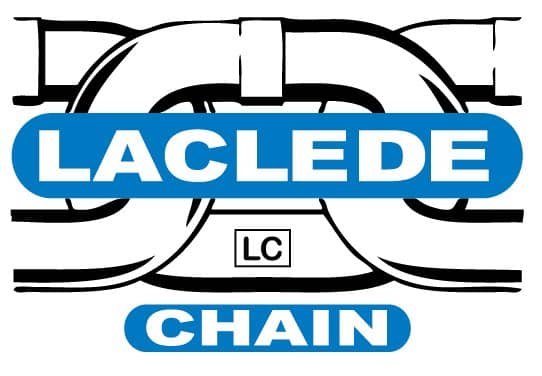How Different Attachment Styles Affect Trailer Safety Chain Performance
By Eric Kazmierzak and Melissa Searle, Laclede Chain Manufacturing
When designing a trailer, what’s the best way to attach the safety chain to the tongue? There are two main attachment styles commonly used in the trailer industry to attach safety chain to the trailer: bolt-on and weld-on clevis assemblies. Laclede Chain collaborates often with trailer manufacturers, and they kept asking us the same question: “Do safety chains perform better with a bolt-on or weld-on clevis attachment?”
So we decided to conduct our own study to evaluate whether these different attachment styles impacted the tensile strength of the trailer chain and the trailer tongue.
The Study
Before we got started, we conducted an independent chain test to verify the tensile strengths of the chains we planned to use in our study. The chains we planned to use were rated in accordance with the Gross Vehicle Weight Rating (GVWR). All of the chains we tested exceeded the ultimate breaking strength.
It’s important to note that we were unable to simulate every environmental force you’d encounter in the field during our testing. One factor we cannot recreate was the shock load sensation that you would normally encounter when a failure occurs. Another force we cannot accurately simulate in the lab is gravity because Laclede uses a vertical tensile tester. In a real-world application, the trailers are being pulled horizontally, which means we do not have the downward force being applied on the chains from the trailer tongue dropping onto the chains. We also made sure the trailer tongues were secure in our machine for the safety of our team members.
Bolt-On Attachment Style Testing
For our bolt-on testing, we used three different trailer grades: class 2, class 3, and class 4. On the class 2 and 3 trailers, the chain bolted on the inside of the trailer tongue, while the class 4 trailer had a separate aluminum box attached to the outside of the frame with a bolt securing it to the trailer. We want to thank Triton Trailers for generously donating the trailer tongue assemblies for use in our testing.
The class 2 trailer we tested had a GVWR of 3,500 pounds, and we tested it with our 5/0 straight coil chain. In the first three tests, we pulled to the GVWR and observed no damage or disfiguration to the chain, the components, or the trailer itself. On the last test, we pulled until a failure occurred and discovered that the S-hook began to open up at about 9,000 pounds of pressure.
Next, the class 3 trailer we used had a GVWR of 5,000 pounds, and we used our ¼” G30 long link chain for testing. Again, we pulled to the GVWR three times and found no observable damage or disfiguration to any of the components. When we pulled to failure on the fourth test, the bolt pulled through the trailer around 7,600 pounds, shearing the aluminum frame.
Finally, our class 4 trailer had a GVWR of 14,000 pounds, and we used our ⅜ G43 chain to test. We pulled it three times to the GVWR with no issues. When we attempted to pull to failure, we had to stop the testing at 19,400 pounds because the aluminum on the trailer started to fail at the attachment point.
Weld-On Clevis Attachment Style Testing
For our clevis weld-on chain retainer style testing, we used one class 2 and three class 4 trailer tongues with different fabrication methods.
First, we tested the class 2 trailer (GVWR of 3,000 pounds) fabricated with 3” tubing using our 5/0 straight coil chain. The first three tests produced no failures or deformation. On the final test, around 9,800 pounds, we stopped the pull tester when we observed the S-Hook began to open up.
Next, we tested a class 4 trailer tongue (GVWR of 14,000 pounds) that was fabricated from 6” C-channel using our ⅜” G43 chain. During the first three tests, we stopped the pull tester around 14,000 pounds and did not observe any damage or disfiguration to the chain or clevis attachment. However, the load pins started to bend during each test, which required us to use a new set for each test.On the final test, we wanted to pull until a failure occurred. Unfortunately, the test fixture that the C-channel was attached to failed at 17,300 pounds so we could not proceed with pulling the actual trailer tongue until failure.
Next, we tested a class 4 trailer (GVWR of 7,000 pounds) fabricated from 4” tubing using our 8/0 straight cross-chain. For this test, we did not want to damage our backup fixture, so we restricted our pull to 7,000 pounds three times with no signs of damage or disfiguration.
Finally, we tested a class 4 trailer (GVWR of 14,000 pounds) fabricated out of 8” tubing using ⅜” G43 chains. There were no signs of damage or disfiguration after three tests to the chain or attachment itself, but like in the previous 14,000-pound tests, the load pins started to deform again.
Conclusion
Both attachment styles that we tested met breaking strength specifications during the study. An advantage of using the clevis weld-on chain retainer attachment is that the end link of the chain is free-moving, unlike the bolt-on attachment. However, it’s important for manufacturers to ensure that clevis attachments are rated appropriately based on the particular trailer’s GVWR. Our study proved the importance of never exceeding a trailer’s GVWR during use in the field, and that it’s critical to check all trailer and safety chain components before and after hauling to ensure there is no damage.
Have questions about trailer safety chains or need to request a quote? Our team is standing by ready to help. Request a quote online or call us at 800-325-2699 today to speak with a Laclede expert!





